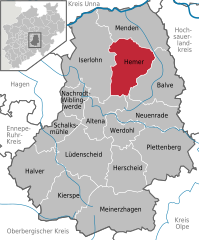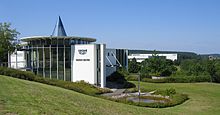Hemer
Burial mounds show that around 1250 BC, Bronze Age shepherds and farmers lived in the area.
Hemer was first mentioned in 1072 by its old name Hademare in a document of Anno II, Archbishop of Cologne, granting lands to the newly founded Benedictine Grafschaft Abbey, including St. Vitus's church and two farms, the later de:Haus Hemer and the de:Hedhof.
The boundary with Cologne, formed by the valley of the Hönne river southeast of Hemer, was protected by Klusenstein Castle, built in 1353.
The three industrial municipalities of Hemer, Sundwig and Westig had already grown into a single urban area by World War I.
With effect from August 1, 1929, Hemer, Sundwig and Westig, as well as Landhausen and the remains of Calle were merged, covering an area of 26.82 km2 (10.36 sq mi) and having a population of 13,809.
The rural Brockhausen had only 588 inhabitants, and because of its low income was not considered to be financially viable as an independent unit.
In January 1934 it was decided to build three barracks in neighboring Iserlohn, which however was unable also to provide enough free land for a training area.
At a meeting in June, land around the village of Apricke was selected, of which 3 km2 was bought by the state in autumn of the same year.
On October 30, 1936, an official garrison contract between Hemer and the state was signed, which included the building of permanent barracks.
Inadequate equipment remained a problem throughout the whole of the war, both because the material was needed at the front, and also because the camp was permanently overpopulated.
In 1974 Kesbern became part of Iserlohn, while the other municipalities of Becke, Deilinghofen, Frönsberg and Ihmert were added to the town of Hemer.
However, when Reiner Hermann was forced to resign in 1994, shortly after the new system was adopted, Hemer became the first commune of North Rhine-Westphalia to get a professional mayor in 1995.
The Felsenmeer nearby is a small Karst area, partially created by medieval mining, now located in a beech forest.
Shared with Menden and Balve is the Hönnetal, a narrow valley with some beautiful cliffs carved into the same limestone bedrock by the river Hönne.
The three golden wolf-hooks are derived from the arms of the Brabeck family, the owners of the manor Haus Hemer.
The red and white motif was used in the form of a bordure round the whole shield, which was completely black with the three yellow wolf-hooks in the middle.
A draft using industrial symbols was made by Treude, but the director of the Prussian state archive in Münster, Professor Ludwig Schmitz-Kallenberg, advised against it.
When it was restarted in the 1930s the original suggestion of Professor Johannes Bauermann of the Prussian state archive was followed, with final artwork by the herald Waldemar Mallek.
Becke, Deilinghofen and Frönsberg combined them with coats of arms of former noble families of the municipality, while Evingsen, Ihmert and Kesbern combined them with symbols representing their main industries - shoe making for Evingsen, wire production for Ihmert and agriculture for Kesbern.
During the Great Depression as well as in the final part of World War II many companies went into bankruptcy, but even today the industrial sector is above average in Hemer.
Because of a significant decline both in passenger numbers and in quantity of goods traffic, the service was wound up, and the last regular train went through Hemer on 27 May 1989.
Renamed Iserlohner Kreisbahn AG in 1942, operations were only briefly interrupted after World War II.









